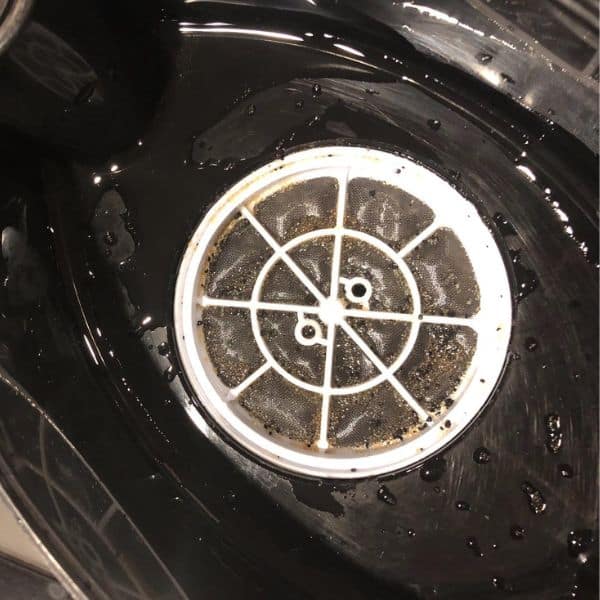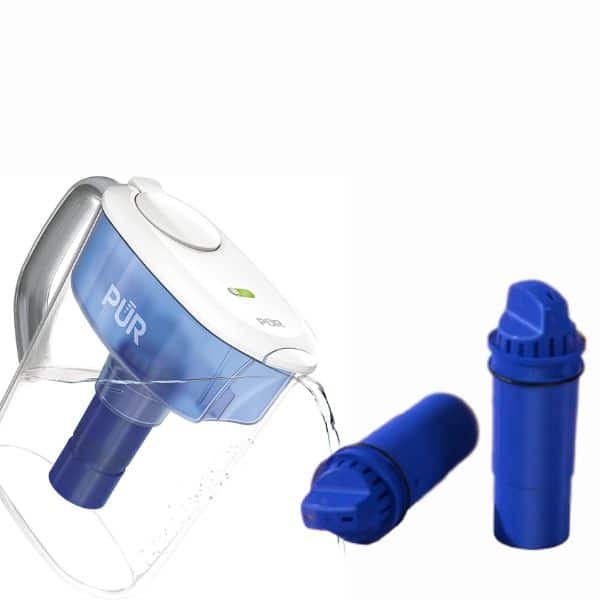How Do PUR Water Filter Pitchers Work?
PUR Water Filter Pitchers are popular for home water filtration systems. These pitchers use PUR’s patented filter technology to remove contaminants from water before it is consumed, giving families peace of mind when drinking tap water. These pitchers’ filters combine carbon and ion exchange to trap and reduce impurities like chlorine, lead, mercury, and more.
The filter cartridge housing contains activated carbon from coconut shells that absorb odors and unpleasant tastes. This carbon in the filter housing also removes particles like dust or rust that may be present in the water supply. In addition, an ion exchange resin helps reduce some of the heavy metals found in tap water, like copper or zinc.

Troubleshooting PUR Water Filter Problems
If you have a PUR water filter in your home, you may encounter occasional problems with its performance. Troubleshooting the filter and resolving any issues quickly can help ensure that it continues to provide clean, safe water for your family.
Slow Flow Rate
Slow flow rates in your PUR filter pitchers can be caused by several common issues such as:
Filter needing replacement
If you are experiencing a low water flow rate from your PUR faucet filter, this may be because it needs to be replaced.
When using PUR faucet filters, the filters should be changed every few months. Over time, the filter will accumulate dirt and debris, and this can limit the flow rate of your water. If the filter has yet to be replaced within the recommended time frame, it could cause a decrease in water volume coming out of your faucet.
To ensure that your PUR filter pitcher is working correctly, changing or replacing filters every two months is essential for optimal performance. Doing so will help keep your tap water clean and free from contaminants while ensuring a maximum flow rate when dispensing from your faucet.
Filter not primed before use
Using a PUR water filter is an excellent way to ensure that you always have clean and safe drinking water, but if it’s not used correctly, you may have reduced or no flow coming through the filter. One reason why this might happen is that the filter has not been adequately primed. When a new filter is implemented, it needs to be primed for it to function correctly and provide maximum performance.
Priming the filter involves running cold tap water through the cartridge for about five minutes until any air pockets are cleared out, and a steady stream of water begins flowing from the faucet.

Improper unit installation
If you have recently purchased a PUR Water Filter, it is essential to ensure the unit is correctly installed. Poor installation can lead to a slow flow rate of water and will reduce the effectiveness of your filter.
You should make sure that your PUR Water Filter has been installed correctly. This includes ensuring all connections are secure and that the filter is fitted tightly into place with no gaps or openings. The water should also be turned on slowly so that it does not cause any damage or disruption to the system. Additionally, any springs or valves should be checked for proper alignment, so they do not block or impede water flow.
For optimal performance, it’s suggested that you regularly check and maintain your filter system by inspecting all parts for wear and tear and cleaning any sediment buildup that could further restrict water flow through the unit.
Clogged filter
If you have noticed a slow flow rate from your PUR water filter, the problem could stem from a clogged filter. This is likely caused by sediment build-up over time and can be resolved quickly with some basic maintenance.
To determine if your filter is clogged, first check the flow rate on your faucet without using the filter. If it’s significantly higher than when you use the filter, then this is indicative that something within it needs to be cleaned or replaced. To clean the filter, remove it from its housing and thoroughly rinse both sides under warm running water for several minutes. Repeat this process until no further debris comes off in the rinse water.

Hot source water
Unfortunately, when the water source is hot, PUR filters can experience problems. If you’re having trouble with your PUR water filter due to hot water, there are several steps you can take to troubleshoot and solve the issue.
- Remove the filter and rinse it thoroughly under cold water. This will remove any sediment stuck to the filter’s surface.
- Also, check if the filter has been correctly installed according to the manufacturer’s instructions. If it needs to be installed correctly, this could be causing issues with filtering out contaminants from hot source water.
- Inspecting the filter can also reveal any signs of damage or wear and tear that might interfere with its performance. If it is too old or worn, consider replacing it for optimal filtration results.
Filter Light Not Working
Another common problem is when the filter light needs to be fixed. Having a non-functioning filter light can make it challenging to know when to change your water filter, so troubleshooting the issue is essential.
- The first step in troubleshooting a non-functioning PUR water filter light is to check the power source. Ensure the unit is plugged into an active outlet and reset any circuit breakers if necessary.
- If this does not fix the issue, check for any loose wires or battery connections inside the unit and make sure they are correctly secured if needed.
- You may also need to replace any batteries as necessary.

Filter Light Not Turning Green
The green filter light on the PUR system is designed to indicate that the filter is working correctly. If this light is not turning green, there are several steps you can take to determine the cause of the issue and resolve it quickly.
- First, check that your filter has been changed within the recommended time frame indicated by the manufacturer – typically 3-6 months, depending on use.
- If it has not been changed recently, replace it with a new one, as old filters may cause water flow issues or inaccurate readings from your filter light.
- After replacing your filter, reset your system by pressing and holding down the reset button for three seconds before releasing it. This should ensure your new filter is registered and ready to use.
The Water Filter Light Remains Red After a Filter Replacement
While most people understand the benefits of replacing the filters regularly, it can be frustrating when the RED light indicator remains on after a filter replacement. If your PUR water filter’s red light stays illuminated even after changing out your filter, you can take several troubleshooting steps to get it functioning again.
- The first step is to reset the unit by pressing and holding both buttons simultaneously until the red indicator light turns off – this will usually do the trick!
- However, if that doesn’t work, check that all connections between pieces of equipment, such as hoses and fittings, are secure.
- Make sure no air bubbles are present in these lines, as they can impede proper flow and cause pressure imbalance within the system leading to an incorrect reading from the monitor.
PUR Water Filter Leaking
If you are having issues with your leaking PUR water filter, there are a few troubleshooting steps you can take to identify and solve the problem.
- First, check the water pressure of your faucet. If it is too high, that may be causing the filter to leak. To adjust the pressure, turn off the faucet valve and find an adjustable wrench or pliers to help you twist the regulator nut until you reach desired pressure levels.
- Once that is done, ensure that all PUR water filter system components are securely attached, and remember to check for any loose connections or parts.
- In addition, make sure that none of the parts have been damaged in any way due to wear and tear over time.

Poor Filtration
Troubleshooting the poor filtration issue of your PUR filter can be tricky, and it’s important to figure out what is causing the problem so that your water remains safe to drink.
Improper unit installation
If you’re using a PUR filter, it’s important to ensure it’s installed properly. Poor filtration could be the result of improper installation and usage. Several things must be remembered during the installation process to ensure your filter is working as effectively as possible.
- Before installing your PUR filter, double-check that all components are present and in working order. Ensure the unit is level with the floor or countertop, using a spirit level if necessary.
- When connecting hoses and tubing to the device, use only compatible parts that match the manufacturer’s specifications and avoid cross-threading or over-tightening any connections.
- It’s also essential to flush out any system before use – this helps remove dust particles from water lines that can clog filters prematurely.
Filter needing replacement
Poor filtration of your PUR filter can also be a sign that it needs to be replaced. If you notice cloudy water or an unpleasant odor coming from your filtered water, chances are the filter needs to be changed. Replace your PUR filter regularly to ensure maximum efficiency and quality of filtered water.
The recommended time frame for replacing a PUR filter varies based on usage and type of filter but typically should occur every two months. You know it is time for a new one when visible signs appear, such as decreased flow rate or discoloration of the device itself.
Cartridges may also become clogged with particulate matter over time, making them ineffective at further filtering out impurities.
Troubleshooting these problems is a straightforward process that can save time and frustration.
How Do You Reset PUR Water Filter Light?
Knowing how to reset the light on your filter can take time and effort. If you need help returning to enjoy fresh water from your filter, here’s what you need to know about resetting the light.
- The first step is ensuring the old filter has been replaced with a new one and installed correctly in the faucet or dispenser.
- Once that is done, press the reset button until it clicks. This will clear any remaining memory of the old filter and allow your PUR Water Filter Light to start functioning again as usual.
- It’s important to hold down only a little bit or press too hard, as this could damage your machine’s internal components, resulting in costly repairs!
Conclusion
Troubleshooting a PUR Water Filter can be simple when following the steps outlined above. It’s important to remember to always refer to the manufacturer’s instructions to ensure you are using your water filter correctly. Additionally, if your PUR Water Filter is still not working after troubleshooting, contact the manufacturer or a local appliance service provider for assistance. Finally, changing your water filter regularly will help reduce future issues and maintain the optimal performance of your water filter.

